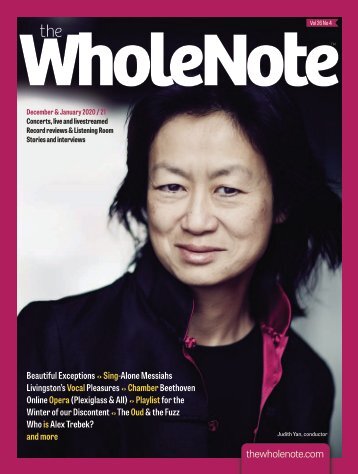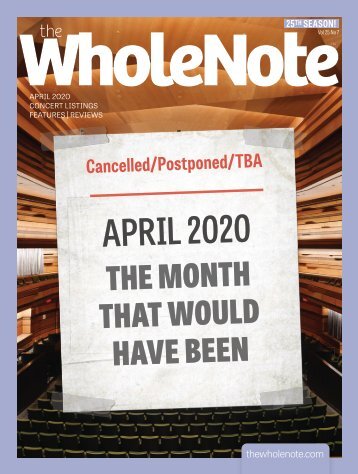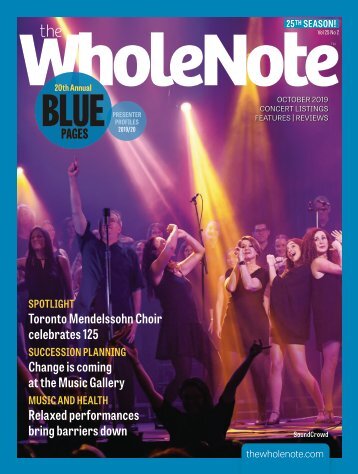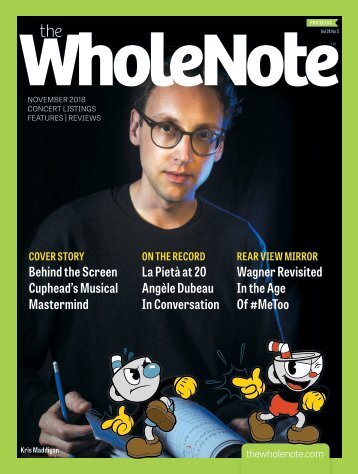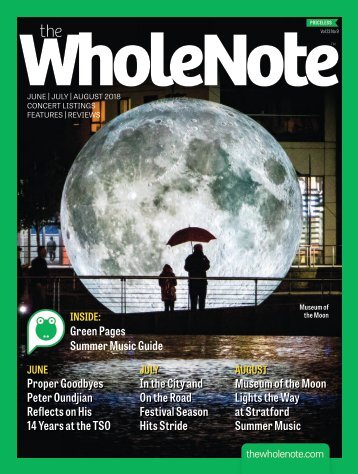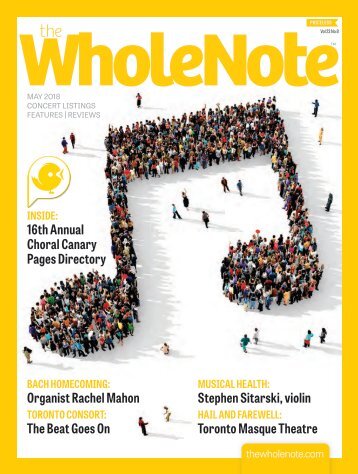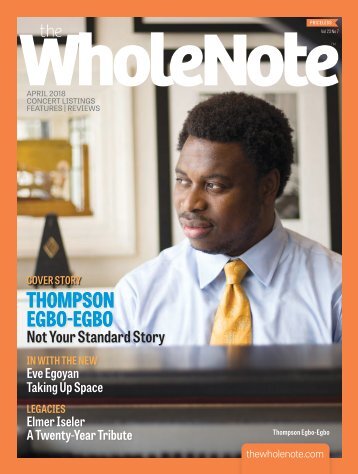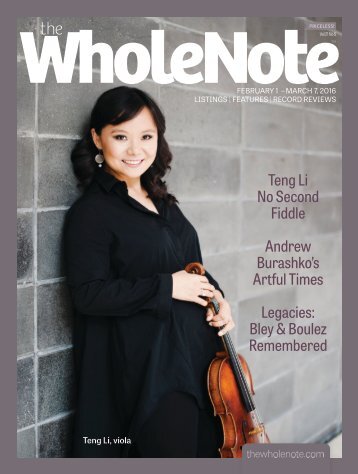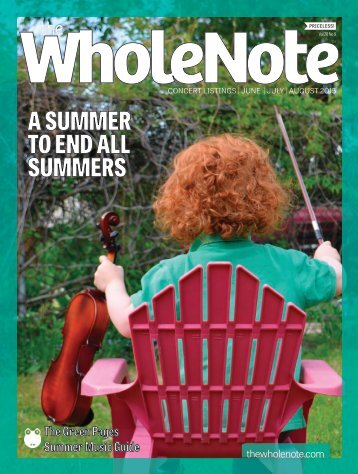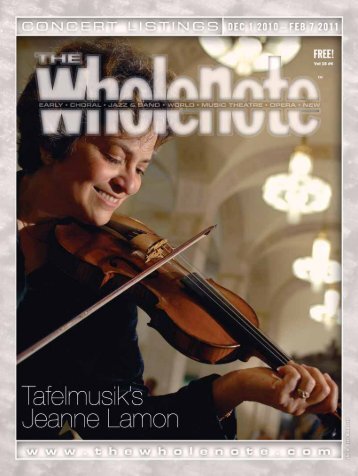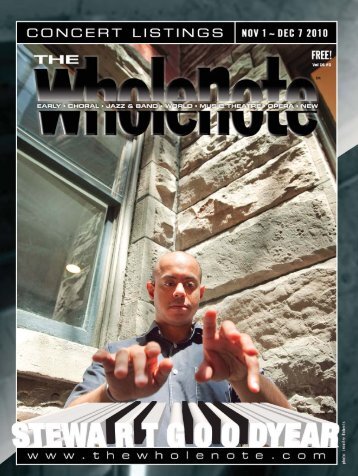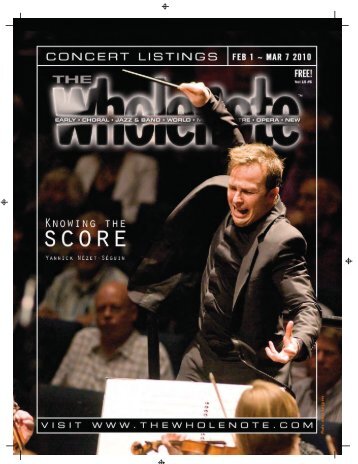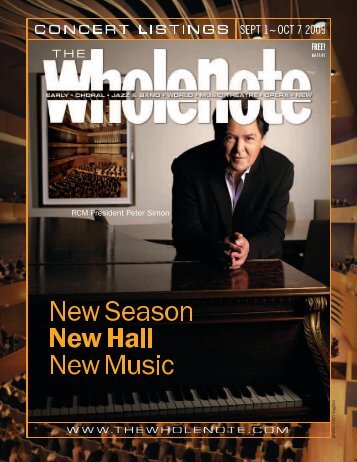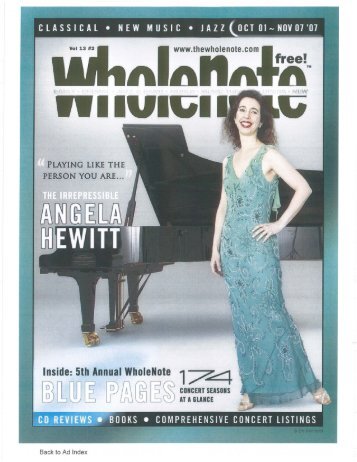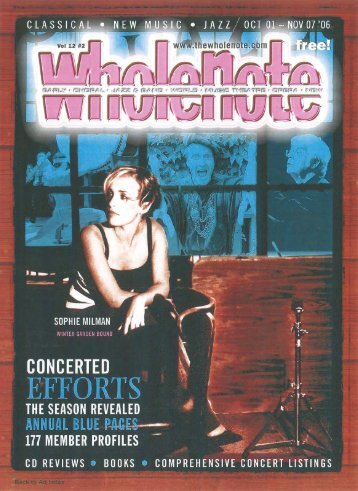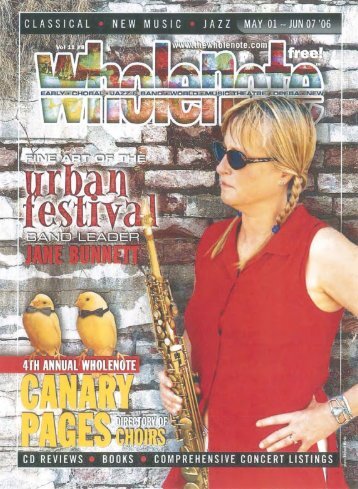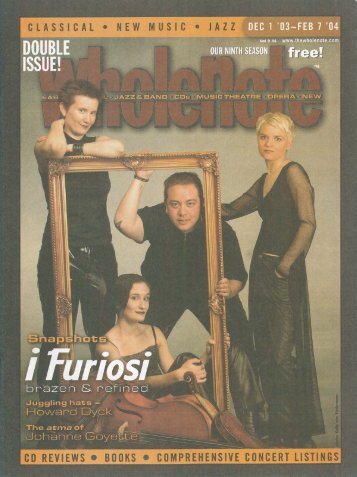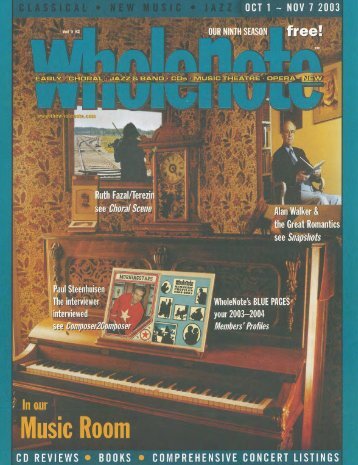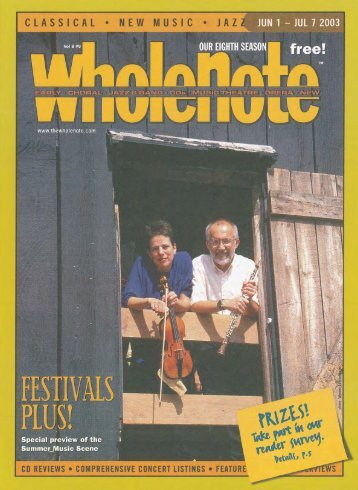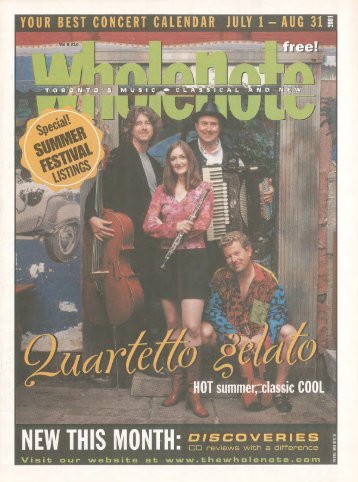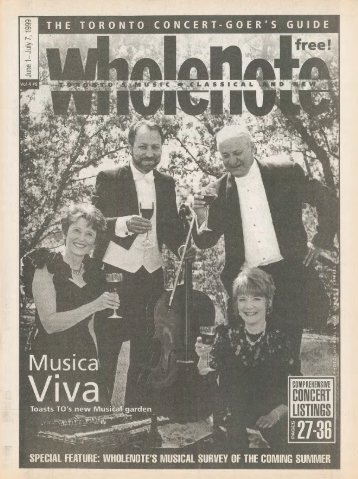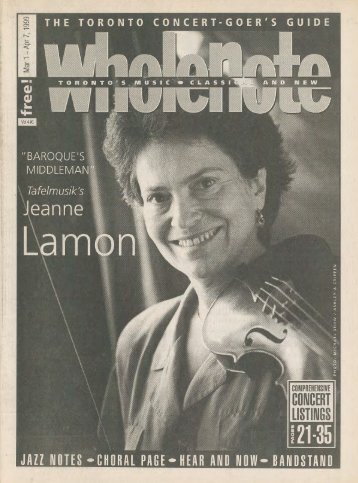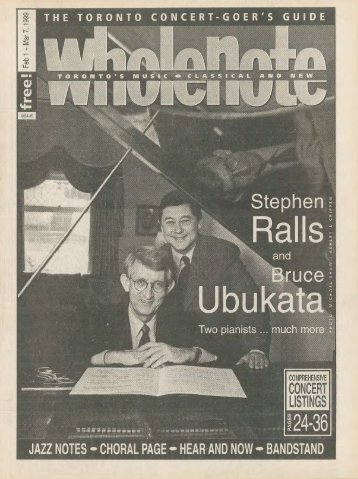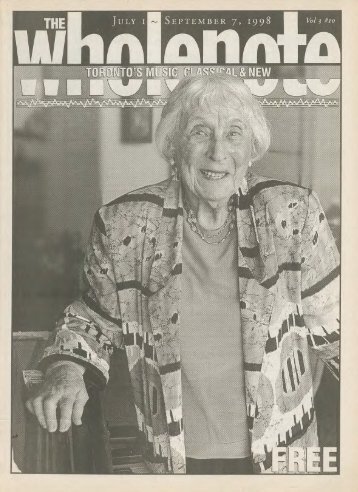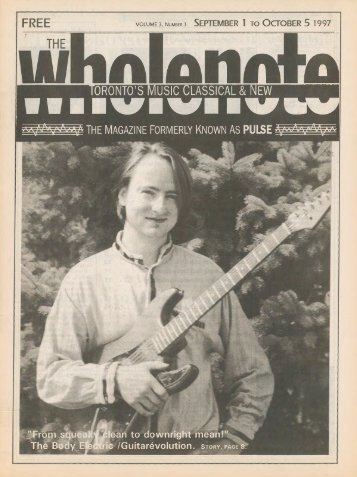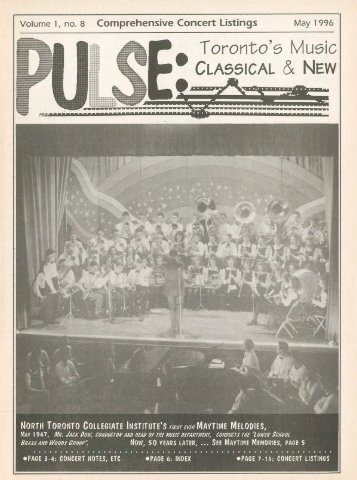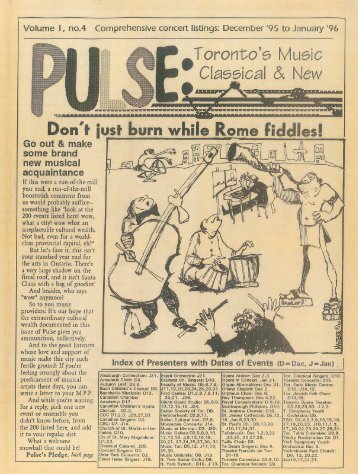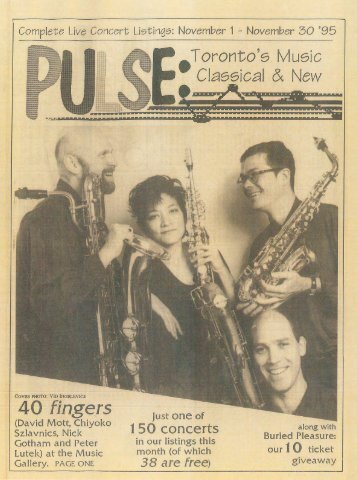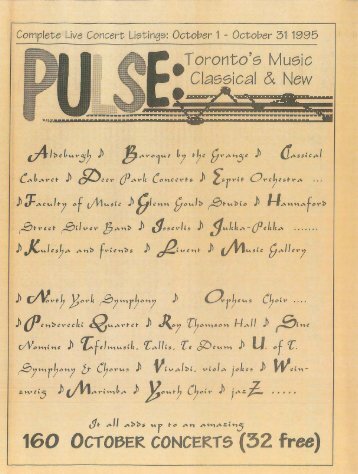Volume 14 - Issue 7 - April 2009
Sonic Mosaics:
Sonic Mosaics: Conversationswith Composersby Paul SteenhuisenUniversity of Alberta Press344 pages, photos; .95Canadian composer andwriter Paul Steenhuisensurveys contemporaryCanadian music - andcontemporary music ingeneral - by interviewingtwenty-six of Canada'smost interesting composers,along with sixEuropean and Americancomposers I ike PierreBoulez and George Crumb.Steenhuisen shows an understanding of thework of everyone he interviews, no matter whattheir musical style. This especially pays off withan experimental composer like John Oswald,whose technique of plunderphonics challengestraditional approaches to composition. Things getlively when he asks Oswald whether his pieceshave an expiry date. Steenhuisen's questions arethought-provoking, and his thorough preparationallows him to follow wherever the subject takeshim. A surprising answer can turn things in anentirely different direction.One of the most engaging aspects of this bookis the way Steenhuisen approaches the issuesinvolved in being a Canadian composer, andwhether Canadian music has "a certain sound, aunique aesthetic" . John Weinzweig can't identifywhat the sound is, but insists that it exists. JohnBeckwith says, "There is a Canadian repertoireand it goes back further than most people areaware." But later he says, "Your music doesn'tget played very much if you're Canadian." GaryKulesha goes even further, saying, "At thismoment there is no Canadian composer who hasa substantial international presence." BarbaraCroall, whose mother is Aboriginal, adds a morepositive dimension when she says that her identityas a Canadian lies in the intuitiveness of hercreative process.Almost all the interviews that make up thiscollection were originally published in WholeNoteMagazine. Most of them relate to a particularperformance or recording. In some cases, thismeans that the questions focus so narrowly on asingle work that you don't get a well-roundedpicture of the composer's musical personality,especially with someone as multi-faceted as R.PAMELA MARGLES' BOOKSHELFMurray Schafer.Steenhuisen makes no claims to have interviewedevery significant Canadian composer, and,inevitably, a number are absent. But of the thirtytwocomposers interviewed, just five are women.In a country where women composers havealways played a major role, this is adisproportionately small representation. But manythings in this important book have been particularlywell-considered, from the design, the photos andthe cover art, to the discography, annotations,and index (which even has an entry forplayfulness).Moving to Higher Groundby Wynton MarsalisRandom House202 pages, photos; .00Wynton Marsalis coveredthe same territory in previousbooks. But now heis not just describing theways jazz can touch yoursoul and stir up your senseof beauty. What he's sayingis that jazz can teachconcrete life lessons - tolisteners and players alike.It teaches you to recognizeHOLD YOUR NEXT RECITAL-beliconian ballA beautiful restored Carpenter's Gothic board and batten churchMoving toHigher GroundW11nto11Marsa lisyour strengths and weaknesses, develop your ownunique sound, and learn to work things out withother people. His explanations of what jazz is areas good an I've ever read, and his comments onmusicians he has known, 'Lessons from the Masters',are fascinating. Mostly he is admiring, but,to illustrate his 'Be true to your dreams, don'tcompromise' mantra, he comes down hard onMiles Davis for selling out towards the end ofhis career.Marsalis, a well-known jazz and classicaltrumpeter, composer, and director of Jazz atLincoln Center, offers an insider's perspective,having known and played with almost all the greatplayers of his time. He understands what makesthem great. Sometimes he goes too far, writingthat "jazz musicians get closer to expressing theactual diversity in the ways of love than anymusicians before them." But we get the ideanonetheless.Terrific anecdotes illustrate his points.There's the time, as an overeager kid, he firstplayed for Harry "Sweets" Edison, and Edisonsaid "Man, you just played more notes than Iplayed in my entire career."Marsalis is fortunate in his co-author GeoffreyWard. "One touch of his hand on the piano andthe moon entered the room" is a lovely evocationof Ellington's piano playing. A pithy commentabout Dizzy Gillespie, "His playing showcasesthe importance of intelligence", says much aboutthis eloquent book as well .The Cello Suites: J. S. Bach, Pablo Casals,and the Search for a Baroque Masterpieceby Eric SiblinHouse of Anansi Press328 pages; .95An encounter with Bach'ssolo Cello Suites at a concertin Toronto, a chanceconversation in a Montrealcafe with an elderly cellistwho turns out to be a"living breathing link withthe past", the opportunityto study the oldest existing score of the Suites ina Brussels library - all this spurs Eric Siblin touncover the story behind the Suites.Siblin never found Bach's original score. Buthe did find a copy of the same edition of theSuites that Pablo Casals had discovered in 1890,which had lead the young cellist to perform themtogether for the first time in their history. "I hadstumbled into my own prelude," writes Siblin.The former Montreal pop music critic is curious,resourceful and passionate. Even though this is atale of personal discovery, Siblin knows when toget out of the way. So we get biographies ofBach, and Casals, as well as the performancehistory of the Suites.Siblin is a skillful writer. His passion for themusic and instinctive grasp of the issues comesthrough. He has done extensive research, althoughhe gets a few minor things wrong. For example,the Berkeley Symphony, which Kent Naganoconducted for almost thirty years, is hardly an"amateur hippied-out" orchestra. The instrumentthat Dmitry Badiarov promotes for the sixth suiteis the violoncello da spalla, which is held on theshoulder, not the violoncello piccolo, which is infact held like a cello. He offers a reliable bibliographyto back up his research. But, frustratingly,his endnotes are hidden at the back, with nothingin the text to indicate what they are annotating.Siblin is right that the Cello Suites provide aperfect entree into the sound world of Bach. Heprovides a delightful and illuminating journey intothat world.A SINGING VACATION IN OXFORD!July 17- Aug. 1, 2009 -l 6th summerJoin us for 2 weeks of the ultimate choral/travel experience.Every morning, sing church-music selections from the lastthousand years in Balliol College Chapel. Total cost including air,building in the heart ofYorkville can be rented at reasonablerates for musical events. Steinway Grand piano included.A high, vaulted ceiling provides excellent concert-hall acoustics.college room with ensuite bath, most weekday meals, side trips,tuition, music and laxes: ,900 (single), ,650. (pp/double).Brochure or info: Tim or Mary Elia at Oxford Churchmusic, (416) 961-6136Capacity up to 120. Tel: 416-922-3618 Fax: 416-922-2431or Cell: 416 726 7157, or Debra House at Egan Travel (905) 272-3055.www.heliconianclub.org rentals@heliconianclub.org E-mail oxfordchurchmusic@rogers.com Web: www.oxfordchurchmusic.ca52 WWW. THEWHOLENOTE.COM APRIL 1 - MAY 7 2009-..,
DISrecordings reviewedEDITOR'S CORNERDo all good things come to those who wait?This month I really had no idea what I wasgoing to write about until the arrival of twodiscs from ATMA which brought back musicalmemories from my formative years. Thefirst was the Alcan Quartet performing stringquartets of Ernest MacMillan and GlennGould (ATMA ACD2-2596). These two importantCanadian works are rarely performedalthough there have been a few recordingsover the years. MacMillan began work on theString Quartet in c minorwhile interned as a civilianprisoner in Germany duringthe First World War.He had been attending theWagner Festival in Bayreuthat time the war brokeout. Although the quartet shows some influenceof Ravel and Debussy - MacMillan hadbeen in Paris before heading to Bayreuth - itmost firmly reflects the composer's roots in theEnglish school of the time. It is charming andwell-crafted and ever since first hearing it somefour decades ago on a Deutsche Grammophonrecording by the renowned Amadeus Quartet Ihave wondered why it has not become a stapleof the repertoire. The Gould quartet, completedin 1955, is a bit problematic. An extendedsingle movement work lasting more than halfan hour, it is a brooding backward-lookingpiece which reflects Gould's interest in the earlyworks of Schoenberg and the New VienneseSchool as well as Brahms and Richard Strauss.There are fugal elements, as we would expectfrom someone who spent his life immersed inthe work of Bach, and occasional sunny bits,but for the most part this is a dark and at timestroubling piece. The Alcan plays both workswith passion and conviction. Their sound iscaptured in full fidelity by producer-recordistAnne-Marie Sylvestre in the warm acoustic ofSalle Frarn,:oys-Bernier at Domaine Forget.The recording also includes MacMillan's mostfrequently performed instrumental work "TwoSketches on French Canadian Airs" with therollicking waves of "A Saint Malo" bringingthe disc to a vibrant conclusion.One of my most important early classicalmemories is from a rehearsal I was privilegedto attend at Hart House back in my high schoolyears. Walter Babiak was conducting a stringorchestra in Ernest Bloch's Concerto GrossoNo.l. I'm afraid I can't remember who thepianist was on that occasion(it's an obbligato rolerather than a virtuosic one)but the work was imprintedon my brain and left alasting impression. Onceagain I cannot understand why this piece isnot more frequently performed and so it wasa great pleasure to find it included on the newCD Schindler's List (ATMA ACD2-2579)featuring the Swiss Orchestre SymphoniqueBienne. The title work is John Williams' suitefor violin and orchestra extrapolated from thesoundtrack to "Schindler's List". Both thatand Bloch's "Suite Hebrai'que" feature theoutstanding young Canadian violinist Alexandreda Costa who is in fine form here. But thehighlight for me is the performance of Bloch'sConcerto Grosso under the direction ThomasRosner who captures the rustic energy of thedance movements and brings a driving force tothe fugal finale without sacrificing any of theinherent stateliness of the work. And in thisinstance I can tell you the name of the pianist,Marc Pantillon.The ATMA package also included an eclecticoffering entitled La Rencontre (ATMAACD2-2608) featuring Anne-Julie Caron,a young marimba player who won the QuebecOpus Prize for "Discovery of the Year"in 2007. The disc includes original works byAmerican marimbist-composer Julie Spencer,Ukrainian-Canadian composerOleksa Lozowchu,French percussionist EmmanuelSejourne, Argentineanguitarist-composerGuillio Espe! and Japanesemarimba virtuoso KeikoAbe, along with Caron's own transcriptionsof works by Pat Metheny and Astor Piazzola.Many of the works show influences of jazz andfolk-dance rhythms, but there are moments ofcontemplation and abstract expression too. Thehighlight for me is Abe's complex depiction of"Wind in the Bamboo Grove". Caron provesherself up for the challenges throughout thisintriguing recording.When I first saw the next disc I must admit Icringed at the thought of more than an hour'smusic for just piccolo and piano. The piccolo'sregister is so high and its timbre so often shrillthat I could not imagine listening to the discin its entirety. But I was amazed to find thatafter the first listening I went back and put iton again. National Arts Centre Orchestra piccoloplayer Patrick Healey(aided here by Montrealaccompanist extraordinaireBrigitte Poulin) is a trulyaccomplished performerand the repertoire he haschosen to showcase his instrumentis very effective. I was not previouslyfamiliar with any of the composers on thisdisc except Denis Gougeon whose Canto delPiccolo both concludes and provides the titlefor this disc (XXI-CD2 1620). Perhaps livingcomposers Frank Hannaway, Cecilia McDowall,Michael Isaacson, Mike Mower, and thelate Alan Ridout are well known in the fluteworld. They certainly should be if this disc isany indication.My Guilty Pleasure of the month? Soul StewVolume Two. Produced by bass player RobertoOcchipinti for Modica Music (www.modicamusic.com),this CD features covers of someof the most iconic R&B tunes of the 70s and80s soulfully sung by Michael Dunston. SoulStew was formed in 1990and served as house bandat the Bamboo Club andlater at The College StreetBar. The current offeringwas recorded "live off thefloor" at MacLear Studioseveral years ago, but mixed and masteredby John "Beetle" Bailey in February 2009and launched at Lula Lounge last month. Thedisc proved to be the perfect soundtrack for adrive in the country recently, with its powerfulrhythm section provided by Occhipinti anddrummer Mark Kelso complemented by MattHomer's omnipresent Hammond organ, DavidGray's tasty guitar licks and John Johnson'sfunky saxes. And if you think maybe you'dneed a bigger horn section to do justice tosome of Motown's greatest hits, have no fearbecause the band was filled out by Dave Dunlopand Terry Promane on trumpet and trombonefor this session. Dunston convincinglymakes familiar songs by Sly Stone, Al Green,Billy Paul, Marvin Gaye, James Brown andeven Stevie Wonder his own. The whole carwas singing along.I mentioned that marimba player Anne-JulieCaron won an Opus Prize in 2007. The 2008Opus Prize for "Jazz and World Music Concertof the Year" went to Montreal group LaNef for the project Deserts, subtitled "creativemusic inspired by the deserts of the world".La Nef is dedicated to creating and producingearly, world, and original musics throughcollaborations with musicians from eclecticbackgrounds and artists from diverse disciplines."Deserts" will be released on CD inApril by the Fidelio label (www.fidelioaudio.com). Concert note:You can hear La Nef atthe Music Gallery here inToronto on April 7 wheninternationally renownedtambourine virtuoso (? !)Carlo Rizzo joins ClaireGignac (Artistic Directorand flutes), Patrick Graham (Musical CoDirector and multiple-percussion), AndrewWells-Oberegger (oud, saz, guembri, zhongruan and percussion) and Toronto-based BenGrossman (electroacoustic hurdy-gurdy andpercussion) for a program entitled "Skin - APercussion Blitz".We welcome your feedback and invite submissions.CDs and comments should be sent to:The WholeNote, 503 - 720 Bathurst St. TorontoON M5S 2R4. We also encourage youto visit our website, www.thewholenote.com,where you can find added features includingdirect links to performers, composers andrecord labels and "buy buttons" for on-lineshopping.David OldsDISCoveries Editordiscoveries@thewholenote.comWWW. THEWHOLENOTE .COM53
- Page 4 and 5: RYAN SCOTT percussionERICA GOODMAN
- Page 6 and 7: FOR OPENERS' When is a ploy not a p
- Page 8 and 9: Focus on OPERA:Adrianne PieczonkaIn
- Page 10 and 11: 10o9A Music Festival unlike any oth
- Page 12 and 13: Scene from Opera Lirica ltaliana sN
- Page 15 and 16: DON'T MISS THIS UNPRECEDENTED OPPOR
- Page 17 and 18: CAREER OPPORTUNITIESSt. Michael's C
- Page 19 and 20: ~infqnia1oronLoNURHAN ARMANMUSIC DI
- Page 21 and 22: BEAT BY BEAT: QUODLIBETby Allan Pul
- Page 23 and 24: Looking AheadI have mentioned in ea
- Page 25 and 26: WHOLENOTE LISTINGSSECTIONS 1-4: INT
- Page 27 and 28: Saturday April 04- 1 O:OOam to 1 O:
- Page 29 and 30: chestra. Debussy: Prelude a l'apres
- Page 31 and 32: 839-3411. ; (children under 1
- Page 33 and 34: - 2:00: Toronto Operetta Theatre. G
- Page 35 and 36: See Apr 17.- 2:00: Walmer Road Bapt
- Page 37 and 38: Poppea. See Apr. 25.- 8:00: Massey
- Page 39 and 40: - 8:00: Massey Hall & Roy ThomsonHa
- Page 41 and 42: Edward Johnson Building, 80 Queens'
- Page 43 and 44: LISTINGS: SECTION 2CONCERTS BEYOND
- Page 45 and 46: nette Haas, singer/songwriter. 54 Q
- Page 47 and 48: Every Sun Jazz Brunch 12-3 with Arc
- Page 49 and 50: MarketPlace: Education, Health, Pro
- Page 51: MUSICAL LIFE:WE ARE AllMusic's CHIL
- Page 55 and 56: Liszt - Sonata in B minorPatrice La
- Page 57 and 58: tion to follow 12 years later.Petre
- Page 59 and 60: Lachance. On Continuation (Cryptogr
- Page 61 and 62: April Is Opera Monthcontinued from
- Page 64: Bach St. Matthew PassionApr 2-4 at
Inappropriate
Loading...
Mail this publication
Loading...
Embed
Loading...
























